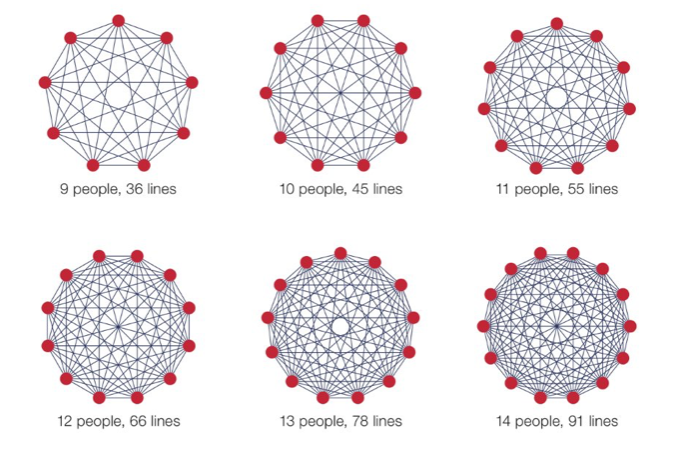I'll save you the wait.
The reason companies get stuck on the growth curve is straightforward; it's communication and trust.
In the early start-up stages, communication is exceedingly simple and trust is inherently high. For teams with less than 7 people, there are 21 possible lines of communication within the group. That's just the internal team; it doesn't account for vendors, clients, and partners. Yet, most teams can succeed at running efficiently without any formal system or processes.

And this is where things start to bog down.
As the company expands from 7 members to 14, the lines of communication exponentially increase from 21 to 91. As the team doubles in size, the lines of communication increase by 6.5x! When this happens, the company must adapt by implementing roles and responsibilities, building on the trust within the team.

When I had Imulus, my software and marketing company, a fellow very successful entrepreneur said, "try to get from 7 to 25 or more as soon as you can. You don't want to be stuck in the middle." Those words proved prophetic as the years went on. I struggled trying to transition from the old "shoot-from-the-hip" management of my team to a clear system of reporting and accountability. Part of the struggle was letting go of my illusion that I saw everything from my perch. If we were to grow, I had no choice but to trust my team and delegate responsibility.
When we moved to 26 team members, it was abundantly clear that our systems served a purpose and each team lead became increasingly crucial to the success of Imulus. I was no longer the driving force. Instead, I shared that responsibility with my team leads. To do that, I needed two things trust and clear communication.
Due to bad timing and poor risk assessment, we never went beyond our 26 members. However, for those companies that grow to 50 employees, there will be 1225 lines of possible communication! In short, that means a 10x in employee growth from 5 employees yields a 122x increase in communication complexity.
Below I've created a quick calculator to figure out how many lines of communication complexity your organization has. Give it a go!
Humanity has succeeded in building organizations and societies that thrived well beyond 50 people. I'm no anthropologist, but I propose humanity historically succeeded through strong authority, low trust, fear, and aligned ideologies. However, we're talking about running an organization in 2022 where fear and authority aren't viable solutions.
More than ever, founders and executive teams need to follow a methodology that aligns everyone in the right direction. We need a high level of trust and crystal clear communication.
"In weak cultures, people find safety in the rules. This is why we get bureaucrats. They believe a strict adherence to the rules provides them with job security. And in the process, they do damage to the trust inside and outside the organization. In strong cultures, people find safety in relationships. Strong relationships are the foundation of high-performing teams. And all high-performing teams start with trust."
― Simon Sinek, The Infinite Game
Starting with trust is fundamental to accelerating the growth curve. Developing a team with aligned core values and shared goals. You achieve this either organically by creating within or intentionally by using an established and proven business operating system. I am partial to Scaling Up, but many others like 3HAG and Traction achieve similar results.
Each system of operation works to simplify the level of communication complexity. With trust at the core, team members can be accountable for the organization's goals. Each team member can be trusted to make "boots on the ground" assessments and decisions based on their front-line evaluation of any situation. This is precisely how the Navy SEALs are so operationally efficient. In their high-trust teams, each operator is empowered to make rapid decisions rather than wait for their chain of command to respond. Using a similar approach in your organization creates agility within your organization, the key to keeping ahead in the game of business.
Lastly, high trust and clear communication lead to employees with a heightened sense of meaning and purpose. These employees stick around, function better as a team, and the overall organizational health goes up. It's these organizations that will dominate in the decades to come.

